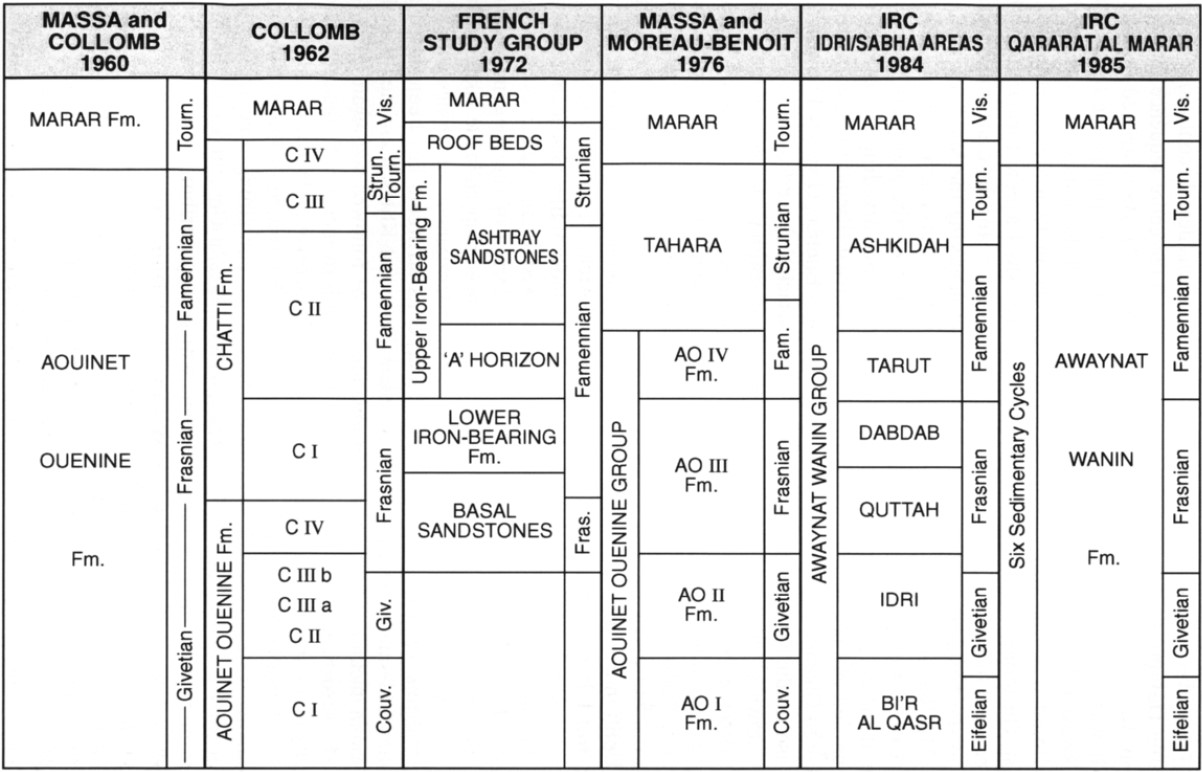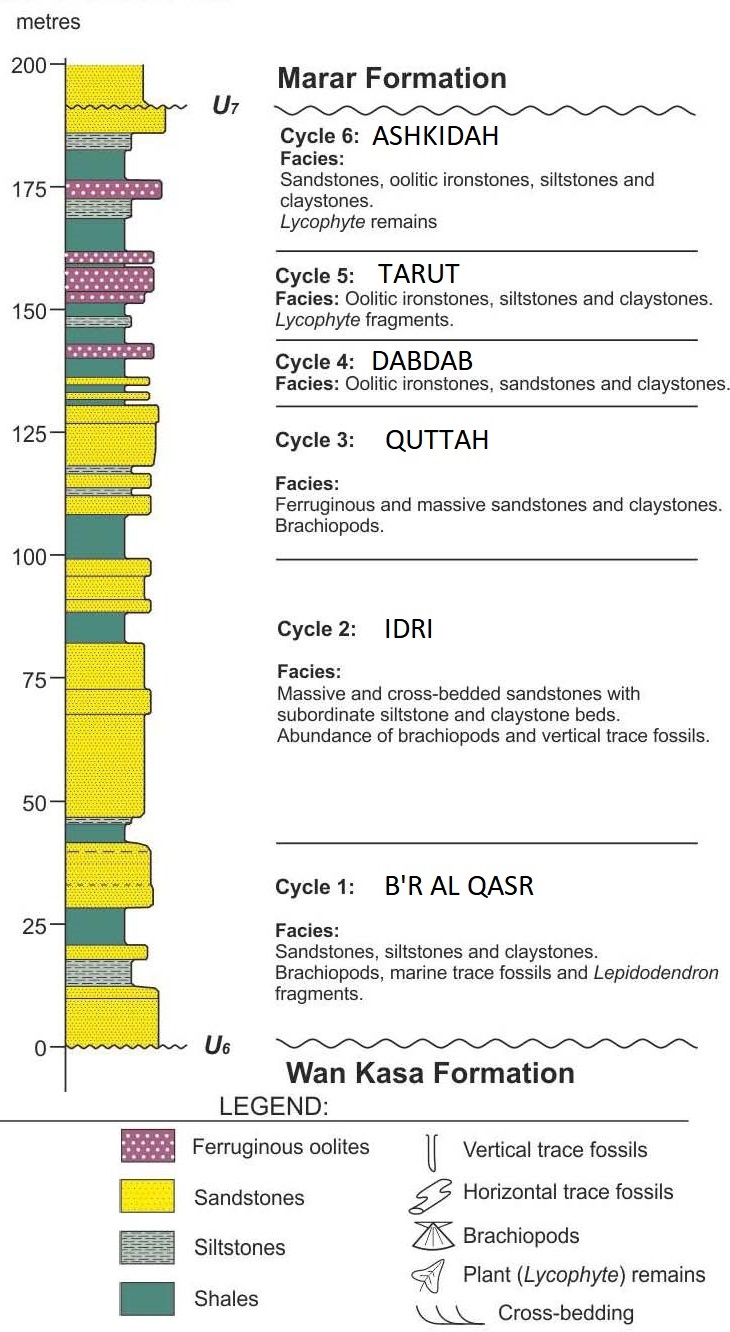Awaynat Wanin Fm
Type Locality and Naming
Northwest flank of the Al Qarqaf Arch, Libya. Lelubre, 1946 & 1948.
References: Lelubre, 1946 & 1948; Plauchut & Faure, 1959; Massa & Collomb, 1960; Jacqué, 1963; Freulon, 1964; Lejal-Nicol, 1972; Klitzsch et al., 1973; Fabre et al., 1983; Lababidi et al., 1985; Mergl & Massa, 1992; Mergl et al., 2001; Shalbak, 2015; Hallett, 2002, 2016.
[Figure 1: Outcrop and subsurface extents of the Awainat Wanin Formation in Libya and into the Djado basin of Niger (Source: Modified from Shalbak, 2015)]
Synonym: Aouinet-Ouenine Fm; Awaynat Wanin Group; Awainat Wanin Fm (misspelling); Aouinet-Ouenine Group & Tahara Formation combined (Fig. 2). The spelling was modified to its current form by Hallet (2002) after verifying the official name records of localities in Libya; Equivalent(s): From Fabre et al. (1983), the Awaynat Wanin could be the equivalent to their combined “*Ohebran (top) and *Dadafuy (bottom) series” in the Djado Basin.
[Figure 2: Successive Nomenclature of the Awaynat Wanin Formation (Source: Hallet, 2002)]
Lithology and Thickness
The type section shows six repeated 'cyclothems' (Fig. 3) of claystone, sometimes ferruginous or gypsiferous, siltstones and sandstones. The sandstones are frequently cross-bedded. In the Djado Basin, Mergl et al. (2001) do not subdivide the Awaynat Wanin into cyclothems since it was difficult to differentiate them. Each cycle is averaging 15-30 m in thickness, with a total thickness of 162 m at the Type Locality.
Without naming the formation, Fabre et al. (1983) mention the Middle and Upper Devonian in the Djado Basin:
With the Middle-Upper Devonian, monotonous clay-sandstone sedimentation appears. The Devonian is only characterized in the region of Chirfa by about ten meters of shales with (PLAUCHUT and FAURE, 1959) Spirifer sp. eg. ascendens POECKELMAN, Leiorhynchus sp. eg. mecacostale CONRAD, Tropidoleptus sp. eg. carinatus CONRAD, lamellibranchs and styliolines which indicate either the Upper Givetian or the Givetian-Frasnian passage. The Upper Devonian, a few tens of meters thick to nearly 200 m, is formed by alternating shales and fine ferruginous sandstone, sometimes calcareous, with Spirophytons, a flora composed of Archaeosigillaria sp. and Protolepidendropsis sp. and Pholadomya, Posydonomya, Mytilus, Tentaculites, encrines and rhynchonella associated with marine incursions (p. 124).
[Figure 3: Stratigraphic Column of the Awaynat Wanin Formation at the Type Locality in Libya, displaying the six cyclothems (Source: Shalbak, 2015)]
Relationships and Distribution
Lower contact
Conformable contact with the underlying Wan Kasa Fm
Upper contact
Overlying unit is the Marar Fm
Regional extent
GeoJSON
Fossils
At Type locality: Mainly brachiopods, sometimes concentrated into coquinas; Desmochitina sp., Ancyrochitina cf. comigera Cell. and Sc., Eisenachitina castor Jans., Vrechitina sp. A Jard and Yapan., Ancyrochitina pilosa var. corta Taug., Ancyrochitina sp. Legault, Fungochitina pilosa Cell. and Scott, Sphaerochitina fenestrata Taug. and Jekh., Lagenochitina macrostoma Taug. and Jekh. In the Djado Basin: Continental influences are increasing with frequent fragments of lycophytes and lignite. In contrast, marine horizons are rare, with few bivalves and crinoids. The trace fossil Spirophyton, generally well preserved and covering sandstones bedding planes, is a more frequent fossil. This ichnofacies is spread over the whole area. Also, abundant but poorly preserved ferruginous wood debris is encountered.
Age
Depositional setting
The sequence represents a deltaic environment ranging from delta front to fluvial-distributary channels, all reworked by tides and storm waves.
Additional Information


